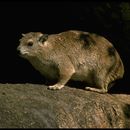en
names in breadcrumbs


Rock hyraxes(Procavia capensis)are found throughout sub-Saharan and north-east Africa, and prefer – as their name suggests – rocky outcrops and cliffs, inhabiting abandoned burrows and crevices they use as shelter.
Despite looking like rodents, rock dassies are actually more closely related to the elephant – based on similarities with their primitive ungulate ancestors from the Eocene era, like teeth and bone structure. Regardless, it is so unique that it’s classified in an order of its own, along with its other subspecies.
Rock dassies look like oversized guinea pigs without tails and rounder ears, with thick brown/grey fur and weigh around 4 kilograms. They have short legs with three toes on their back feet and four on the front. On the bottom of their feet, they have thick, rubbery pads, making it easier to move over rocky substrates. The have long, tusk-like incisors, used for biting off large quantities of vegetation. The iris of hyraxes slightly protrudes over the pupil of their eyes, which decreases the amount of sunlight to their eye.
Rocky hyraxes live in colonies of about 50, with territorial males dominating over harems of a few related females and their offspring. These males are constantly on the lookout for predators and rivals.
These dassies have unusually long pregnancies for animals of their size, and have a gestation period of seven or eight months, new-borns being so developed that they are able to jump and run only two days after birth! They bear between two or three infants at a time.
Procavia capensisis listed as Least Concern on the IUCN Red List of mammals, but do occur in many protected areas across its range.
Interesting fact:
Rock hyraxes have designated areas they use as ‘latrines’, and as time goes by, these urine deposits accumulates and eventually congeals into a large, sticky solid. –Seehow scientists are using these deposits to investigate past climate change!
For more information on MammalMAP, visit the MammalMAPvirtual museumorblog.